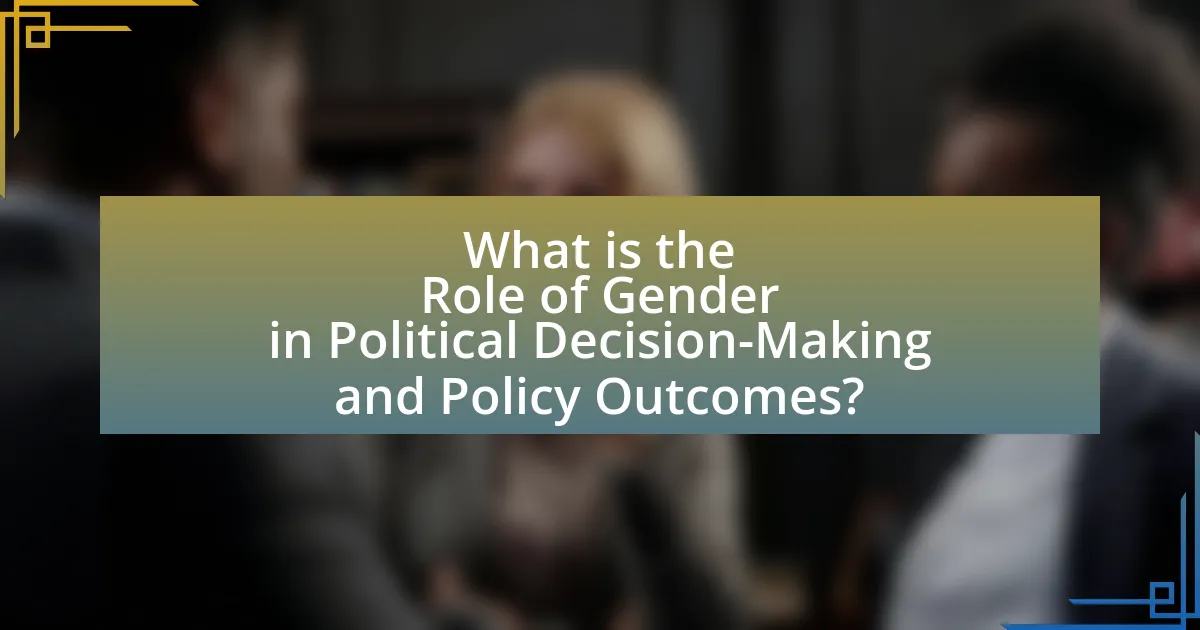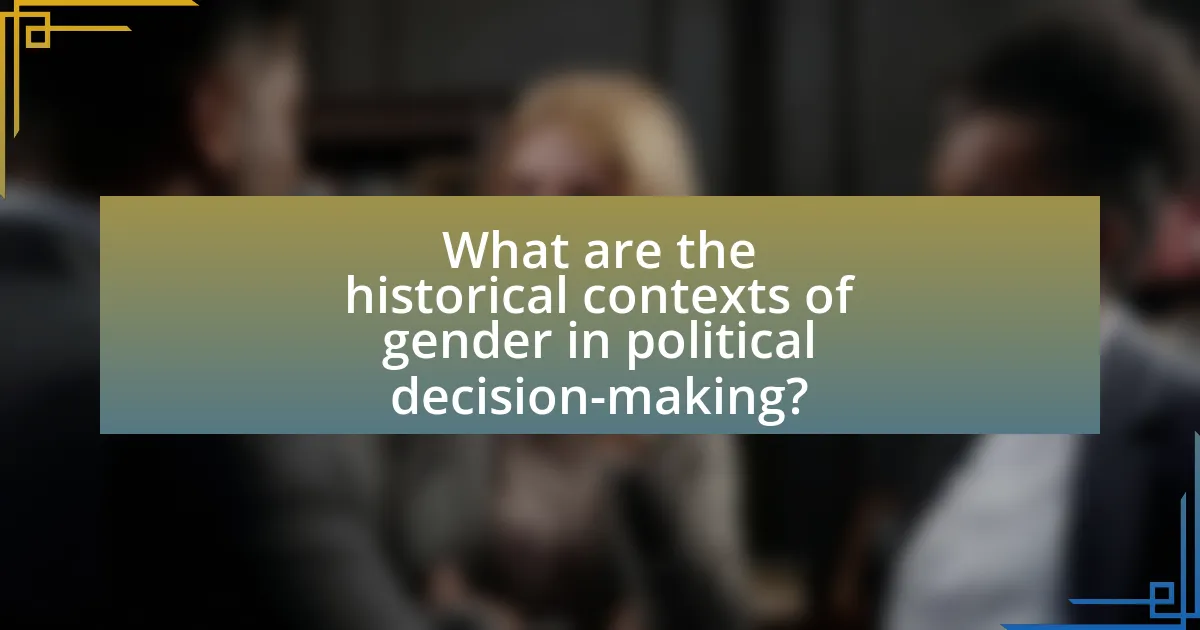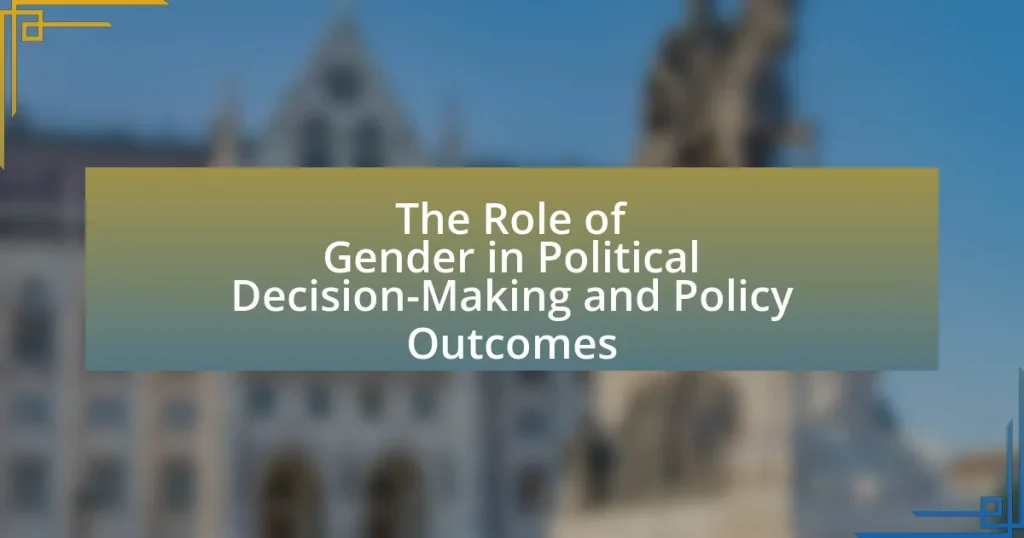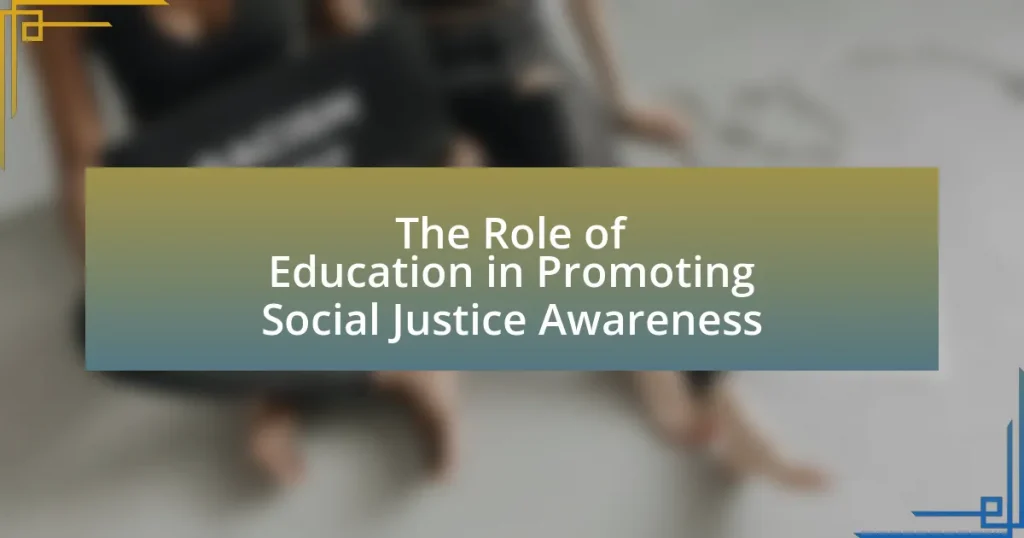The article examines the significant role of gender in political decision-making and policy outcomes, highlighting how women’s representation in governance influences policy priorities, particularly in areas such as healthcare, education, and social welfare. It discusses the barriers to women’s political participation, the impact of gender parity on decision-making processes, and the historical context of gender in politics. Additionally, the article explores current trends, ongoing challenges, and practical strategies to enhance gender equity in political spheres, emphasizing the importance of understanding gender dynamics for effective and inclusive policy formulation.

What is the Role of Gender in Political Decision-Making and Policy Outcomes?
Gender plays a significant role in political decision-making and policy outcomes by influencing the perspectives, priorities, and experiences that shape governance. Research indicates that women in political positions often advocate for policies that address issues such as healthcare, education, and social welfare, which may be overlooked by male counterparts. For instance, a study by the Inter-Parliamentary Union found that countries with higher female representation in parliament tend to have more progressive policies on gender equality and family welfare. This correlation highlights how gender diversity in political leadership can lead to more comprehensive and inclusive policy-making, ultimately affecting societal outcomes.
How does gender influence political representation?
Gender significantly influences political representation by affecting the likelihood of women being elected to office and shaping policy priorities. Research indicates that countries with higher female representation in legislatures tend to prioritize issues such as healthcare, education, and gender equality, which are often underrepresented in male-dominated political environments. For instance, a study by the Inter-Parliamentary Union found that as of 2021, countries with at least 30% women in parliament are more likely to pass legislation addressing women’s rights and social issues. This correlation demonstrates that gender not only impacts who is elected but also the types of policies that are prioritized and enacted in governance.
What are the barriers to women’s political participation?
Barriers to women’s political participation include systemic discrimination, cultural norms, and lack of access to resources. Systemic discrimination manifests in legal frameworks that may limit women’s rights to vote or run for office, as seen in countries where laws are not gender-neutral. Cultural norms often dictate that women should prioritize family roles over political ambitions, which can discourage their involvement in politics. Additionally, women frequently face challenges in accessing financial resources and networks necessary for campaigning, as evidenced by studies showing that female candidates often receive less funding than their male counterparts. These barriers collectively hinder women’s representation in political decision-making processes.
How does gender parity affect decision-making processes?
Gender parity positively influences decision-making processes by enhancing diversity and inclusivity in perspectives. Research indicates that organizations with balanced gender representation are more likely to consider a wider range of viewpoints, leading to more comprehensive and effective solutions. For instance, a study published in the Harvard Business Review found that companies with women in leadership roles experience improved financial performance and innovation, demonstrating that gender-diverse teams make better decisions. Furthermore, gender parity in decision-making bodies can lead to policies that better address the needs of all demographics, as evidenced by the increased focus on issues such as childcare and healthcare when women are involved in political decision-making.
Why is understanding gender dynamics important in policy outcomes?
Understanding gender dynamics is crucial in policy outcomes because it directly influences the effectiveness and inclusivity of policies. Policies that consider gender dynamics are more likely to address the specific needs and challenges faced by different genders, leading to equitable resource distribution and improved societal outcomes. For instance, research by the World Bank indicates that gender-responsive policies can enhance economic growth by up to 2% in developing countries, demonstrating that integrating gender perspectives can yield significant economic benefits. Additionally, studies show that women’s participation in decision-making processes leads to more comprehensive and sustainable policy solutions, as diverse perspectives contribute to better problem-solving and innovation.
What impact does gender have on policy priorities?
Gender significantly influences policy priorities by shaping the issues that are deemed important and the solutions proposed. Research indicates that women in political positions often prioritize social issues such as healthcare, education, and family welfare more than their male counterparts, who may focus more on economic and defense policies. For instance, a study by the Inter-Parliamentary Union found that female legislators are more likely to advocate for policies addressing gender equality and child welfare, leading to a broader range of issues being prioritized in legislative agendas. This shift in focus can result in more comprehensive policy frameworks that address the needs of diverse populations, ultimately affecting the overall effectiveness and inclusivity of governance.
How do gendered perspectives shape policy effectiveness?
Gendered perspectives shape policy effectiveness by ensuring that diverse experiences and needs are considered in policy formulation and implementation. Policies that incorporate gendered insights tend to address the specific challenges faced by different genders, leading to more equitable outcomes. For instance, research by the World Bank indicates that gender-responsive policies can enhance economic growth by increasing women’s participation in the labor force, which contributes to overall productivity. Additionally, studies show that countries with gender-inclusive governance structures are more likely to implement policies that effectively address social issues, such as healthcare and education, resulting in improved societal well-being.

What are the historical contexts of gender in political decision-making?
The historical contexts of gender in political decision-making reveal a long-standing pattern of male dominance in governance and policy formulation. Historically, women have been systematically excluded from formal political roles, with significant barriers to participation, such as legal restrictions and societal norms. For instance, in the early 20th century, women in many countries, including the United States and the United Kingdom, fought for suffrage, which was granted only after extensive activism and advocacy. This struggle highlighted the gendered nature of political power and the necessity for women’s voices in decision-making processes. Furthermore, research indicates that countries with higher female representation in political offices tend to adopt more progressive policies on issues such as healthcare and education, demonstrating the impact of gender diversity on policy outcomes.
How has the role of gender evolved in politics over time?
The role of gender in politics has evolved significantly from exclusion to increased representation and influence. Historically, women were largely excluded from political processes, with the suffrage movement in the early 20th century marking a pivotal shift as women gained the right to vote in many countries, such as the United States in 1920. This change led to gradual increases in women’s political participation, evidenced by the rise of female politicians and leaders, such as Margaret Thatcher in the UK and Angela Merkel in Germany.
By the late 20th and early 21st centuries, gender representation in politics became a focal point, with initiatives aimed at increasing women’s participation, such as gender quotas in countries like Rwanda, which achieved over 60% female representation in parliament. Studies show that diverse political bodies lead to more comprehensive policy outcomes, as women often advocate for issues like healthcare, education, and family rights. Thus, the evolution of gender roles in politics reflects a broader societal shift towards inclusivity and equality, impacting decision-making and policy outcomes significantly.
What key milestones have marked progress in gender representation?
Key milestones in gender representation include the adoption of the 19th Amendment in the United States in 1920, which granted women the right to vote, significantly increasing their political participation. Another milestone is the establishment of the United Nations’ Convention on the Elimination of All Forms of Discrimination Against Women (CEDAW) in 1979, which set an international standard for gender equality. Additionally, the introduction of gender quotas in various countries, such as Rwanda’s constitutional requirement for at least 30% of parliamentary seats to be held by women, has led to increased female representation in governance. These milestones collectively demonstrate significant advancements in gender representation across political systems globally.
How have historical movements influenced current gender policies?
Historical movements have significantly shaped current gender policies by advocating for equality and rights, leading to legislative changes and societal shifts. For instance, the women’s suffrage movement in the early 20th century resulted in the passage of the 19th Amendment in the United States, granting women the right to vote, which laid the groundwork for future gender equality initiatives. Additionally, the feminist movements of the 1960s and 1970s pushed for workplace rights, reproductive rights, and anti-discrimination laws, influencing policies such as the Equal Pay Act of 1963 and Title IX in 1972. These historical movements established a framework for ongoing advocacy, ensuring that gender considerations remain integral to political decision-making and policy outcomes today.
What lessons can be learned from past gender-related political decisions?
Past gender-related political decisions highlight the importance of inclusive representation in governance. Historical examples, such as the suffrage movements in the early 20th century, demonstrate that when women gain the right to vote, policy outcomes shift towards addressing gender-specific issues, such as reproductive rights and workplace equality. Research shows that countries with higher female political representation tend to implement more progressive social policies, as seen in Nordic countries where women hold significant political power. This evidence underscores the necessity of integrating diverse gender perspectives in political decision-making to achieve equitable policy outcomes.
What case studies illustrate the impact of gender on policy outcomes?
Case studies illustrating the impact of gender on policy outcomes include the implementation of gender quotas in Rwanda and the analysis of maternal health policies in Sweden. In Rwanda, following the 1994 genocide, the government established a gender quota that resulted in women holding 61% of parliamentary seats, leading to significant legislative changes, including laws on gender-based violence and property rights. This legislative shift demonstrates how increased female representation can directly influence policy outcomes. In Sweden, the introduction of gender-sensitive budgeting in the 1990s aimed to address gender inequalities in health care and social services, resulting in improved maternal health outcomes and increased access to reproductive health services. These examples underscore the critical role that gender representation plays in shaping effective and equitable policy decisions.
How can historical analysis inform future gender policies?
Historical analysis can inform future gender policies by revealing patterns of inequality and the effectiveness of past interventions. For instance, examining the suffrage movement highlights how strategic advocacy led to women’s voting rights, demonstrating the importance of grassroots mobilization and legislative change. Additionally, studies show that countries with gender quotas in political representation, such as Rwanda, have seen significant improvements in gender equality and policy outcomes, indicating that historical successes can guide contemporary policy frameworks. By analyzing these historical contexts, policymakers can identify successful strategies and avoid previous mistakes, ultimately leading to more effective gender policies.

What are the current trends in gender and political decision-making?
Current trends in gender and political decision-making indicate an increasing representation of women in leadership roles and a growing emphasis on gender-sensitive policies. Research shows that as of 2023, women hold approximately 26% of parliamentary seats globally, a significant increase from previous decades, reflecting a shift towards more inclusive governance. Additionally, studies, such as the Inter-Parliamentary Union’s report, highlight that countries with higher female representation tend to prioritize issues like healthcare, education, and gender equality in their policy agendas, demonstrating the impact of gender diversity on decision-making outcomes.
How are contemporary political systems addressing gender issues?
Contemporary political systems are addressing gender issues through the implementation of gender quotas and policies aimed at promoting gender equality in governance. For instance, many countries, including Rwanda and Sweden, have established legal frameworks that require a certain percentage of women in legislative bodies, resulting in increased female representation and participation in decision-making processes. Research indicates that countries with gender quotas have seen a significant rise in women’s political representation, with Rwanda achieving over 60% female representation in its parliament, the highest in the world. Additionally, political systems are increasingly incorporating gender-sensitive policies that address issues such as reproductive rights, gender-based violence, and workplace equality, reflecting a broader commitment to gender equity in public policy.
What initiatives promote gender equality in political spheres?
Initiatives that promote gender equality in political spheres include gender quotas, women’s leadership programs, and advocacy campaigns. Gender quotas, implemented in various countries, mandate a certain percentage of women in political positions, significantly increasing female representation; for example, Rwanda has over 60% women in its parliament due to such policies. Women’s leadership programs, like the UN Women’s “Women in Politics” initiative, provide training and resources to empower women to run for office. Advocacy campaigns, such as the HeForShe movement, engage men and boys in promoting gender equality, fostering a more inclusive political environment. These initiatives collectively aim to dismantle barriers to women’s participation in politics and ensure equitable representation.
How do political parties incorporate gender perspectives in their platforms?
Political parties incorporate gender perspectives in their platforms by explicitly addressing issues that affect women and promoting gender equality through policy proposals. For example, many parties include commitments to equal pay, reproductive rights, and anti-violence measures in their platforms. Research indicates that parties with higher female representation are more likely to prioritize gender issues, as seen in the 2019 elections in Canada, where the Liberal Party’s platform included a comprehensive gender equality strategy. This approach not only reflects the growing recognition of women’s rights as a critical political issue but also aims to attract a broader voter base that values gender equity.
What challenges remain in achieving gender equity in politics?
Challenges in achieving gender equity in politics include systemic barriers, cultural biases, and inadequate representation. Systemic barriers such as electoral laws and party structures often favor male candidates, limiting women’s access to political positions. Cultural biases perpetuate stereotypes that undermine women’s leadership capabilities, affecting public perception and voter behavior. Additionally, women remain underrepresented in political offices globally; for instance, as of 2023, women hold only 26% of parliamentary seats worldwide, according to the Inter-Parliamentary Union. These factors collectively hinder progress toward gender equity in political decision-making and policy outcomes.
What are the ongoing obstacles to women’s leadership roles?
Ongoing obstacles to women’s leadership roles include systemic gender bias, lack of access to mentorship, and insufficient representation in decision-making positions. Systemic gender bias manifests in workplace cultures that favor male leadership styles and perpetuate stereotypes about women’s capabilities. According to a McKinsey report, women are underrepresented at every level of leadership, with only 28% of senior vice president roles held by women. Additionally, the absence of mentorship and sponsorship opportunities limits women’s professional growth, as studies show that mentorship significantly impacts career advancement. Lastly, the lack of female role models in leadership positions creates a cycle of underrepresentation, making it challenging for aspiring women leaders to envision themselves in such roles.
How does intersectionality affect gender representation in politics?
Intersectionality significantly affects gender representation in politics by highlighting how overlapping social identities, such as race, class, and sexuality, influence women’s political experiences and opportunities. Research indicates that women from marginalized backgrounds often face compounded barriers that limit their political participation and representation. For instance, a study by the Center for American Women and Politics found that women of color are underrepresented in political offices, holding only 4.5% of congressional seats despite making up a larger percentage of the population. This disparity illustrates how intersectional factors create unique challenges that can hinder effective representation and policy advocacy for diverse groups of women in the political arena.
What practical strategies can enhance gender equity in political decision-making?
Implementing gender quotas in political parties and legislative bodies can significantly enhance gender equity in political decision-making. Research indicates that countries with gender quotas, such as Rwanda, which has the highest percentage of women in parliament globally at 61%, demonstrate improved representation and policy outcomes that address women’s issues. Additionally, providing training and mentorship programs for women aspiring to enter politics can empower them with the necessary skills and confidence. Studies show that such initiatives lead to increased female candidacy and participation in elections, further promoting gender equity. Lastly, fostering a culture of inclusivity within political institutions, supported by policies that address gender bias, can create an environment where women are encouraged to contribute to decision-making processes.
How can advocacy groups influence gender policy reforms?
Advocacy groups can influence gender policy reforms by mobilizing public opinion, lobbying policymakers, and providing research-based evidence to support their positions. These groups often engage in campaigns that raise awareness about gender issues, thereby shaping societal attitudes and pressuring decision-makers to prioritize gender equality in policy agendas. For instance, organizations like the Women’s March and the National Organization for Women have successfully advocated for legislative changes by organizing protests and leveraging social media to amplify their messages. Additionally, studies show that advocacy efforts can lead to significant policy shifts; for example, the introduction of the Violence Against Women Act in the United States was largely driven by sustained advocacy from various women’s rights organizations.
What role does education play in promoting gender awareness in politics?
Education plays a crucial role in promoting gender awareness in politics by equipping individuals with knowledge about gender issues and fostering critical thinking. Through formal education, individuals learn about the historical context of gender inequality, the importance of representation, and the impact of policies on different genders. Studies, such as those conducted by the United Nations Educational, Scientific and Cultural Organization (UNESCO), indicate that education increases awareness of gender disparities and encourages civic engagement, leading to more informed political participation. Furthermore, educational programs that focus on gender studies and political science have been shown to enhance understanding of the mechanisms of power and advocacy, ultimately contributing to a more equitable political landscape.















